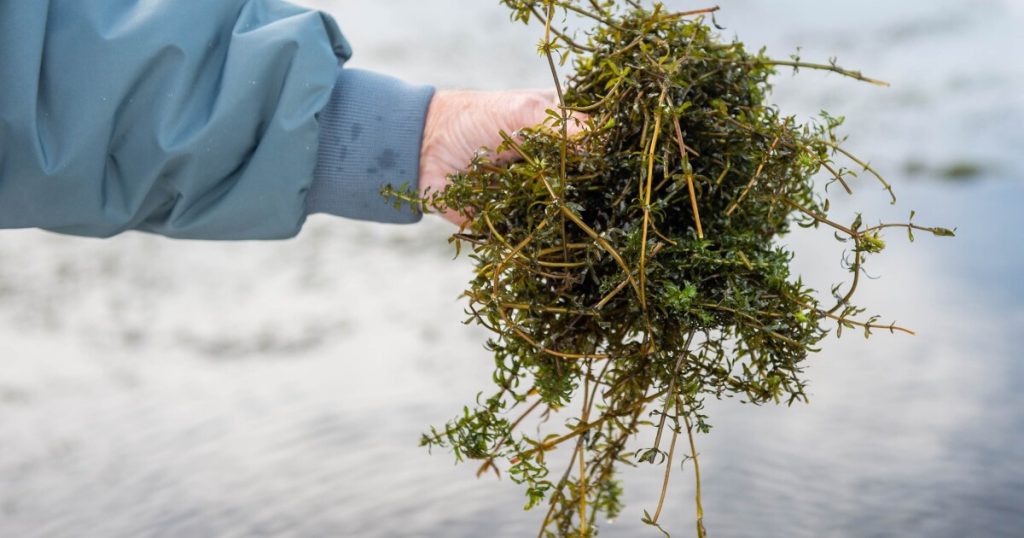Connecticut Battles Invasive Hydrilla with Controversial Herbicide Amidst Public Outcry
DEEP RIVER, CT – A public information session intended to address concerns surrounding the use of the herbicide diquat to control the invasive aquatic plant hydrilla in the Connecticut River devolved into a heated exchange between state officials and residents on Friday. The contentious meeting highlighted the growing anxieties surrounding the chemical’s application and the spread of misinformation online. The state, grappling with the rapid proliferation of hydrilla, maintains that diquat is a necessary tool to combat the ecological and economic threats posed by the aggressive weed, while some residents remain skeptical about the herbicide’s potential impacts on the river’s ecosystem and human health.
Hydrilla, an invasive aquatic plant, has become a significant concern for the Connecticut River ecosystem. Its rapid growth and dense mat formation deplete oxygen levels in the water, posing a severe threat to fish and other aquatic life. Furthermore, the thick mats impede recreational activities like boating and fishing, impacting local economies. State officials emphasize the severity of the hydrilla infestation, describing it as a “monster” that could “suffocate” the river’s wildlife and disrupt recreational and economic activities. The plant’s ability to readily propagate through fragmentation, even attaching to boats in minuscule pieces, makes manual removal impractical and necessitates a more aggressive approach.
The state’s decision to employ diquat as a control measure has ignited a firestorm of controversy, fueled by online misinformation regarding the chemical’s potential side effects. While state officials, including Senator Norm Needleman and Representative Renee LaMark Muir, stress that the diquat application is a carefully regulated, EPA-approved program backed by scientific research, public apprehension persists. The meeting in Deep River underscored the deep-seated mistrust and the urgent need for transparent communication. The absence of a representative from the U.S. Army Corps of Engineers, the entity responsible for applying the herbicide, further exacerbated the situation, leaving residents feeling unheard and fueling the flames of distrust.
Senator Richard Blumenthal, acknowledging the public’s concerns and the importance of open dialogue, pledged to organize a public forum featuring representatives from both the Army Corps of Engineers and the Environmental Protection Agency. This forum aims to provide a platform for direct engagement between concerned citizens and the agencies responsible for the diquat application. While a specific date for the forum has yet to be confirmed, this commitment represents a crucial step towards addressing the public’s anxieties and fostering a more informed understanding of the hydrilla management strategy.
The controversy surrounding the use of diquat highlights the complex challenges associated with managing invasive species. Balancing the need to protect the ecological integrity of the river with public health concerns requires a transparent and collaborative approach. The state’s decision to employ diquat underscores the urgent need to control the spread of hydrilla, but it also emphasizes the importance of engaging the public in a meaningful and transparent dialogue. Open communication, access to reliable information, and opportunities for public input are crucial for building trust and ensuring that management strategies are both effective and environmentally responsible.
While the debate over diquat continues, state officials urge residents to take proactive measures to prevent the further spread of hydrilla. Boaters are advised to meticulously clean, drain, and dry their boats before entering and after exiting the water to minimize the risk of transporting hydrilla fragments. This simple yet effective practice can significantly contribute to containing the spread of this invasive species. The ongoing battle against hydrilla requires a multifaceted approach that encompasses both targeted control measures and public participation in preventive efforts. Only through collaborative action can the long-term health and vitality of the Connecticut River be secured. The state’s commitment to further public forums and continued transparency will be instrumental in navigating the complex challenges posed by this invasive aquatic plant.


